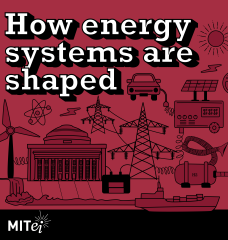
The costs of replacing dispatchable power sources based on fossil fuels with intermittent renewable power sources remain controversial. The life-cycle cost of renewables, in particular wind and solar power, is known to have fallen substantially over time (Jansen et al., 2020; Steffen et al., 2020; Rubin et al., 2015). Once deployed, these power sources also have effective priority in the marketplace due to their zero short-run production cost. In contrast, the life-cycle cost of traditional dispatchable generation sources tends to increase due to lower capacity utilization as these facilities are increasingly relegated to delivering output during hours when intermittent renewables are not available (Bushnell & Novan, 2021; Kök et al., 2020).
While all of these cost effects favor renewable power, countervailing effects emerge on the revenue side (Millstein et al., 2021; Das et al., 2020). First, renewables increasingly experience a "cannibalization" effect in jurisdictions where significant additions of wind or solar power capacity cause market prices to fall during hours when renewable sources are at peak capacity (López Prol et al., 2020, Hirth, 2013). A second effect favoring the value generated by dispatchable energy sources is the price premium they earn at times of limited supply capacity due to the intermittency of renewables (Antweiler & Muesgens, 2021).
This paper provides an integrated assessment of the cost and value dynamics of solar photovoltaic (PV), onshore wind, and natural gas combined-cycle (NGCC) power plants in the context of the wholesale electricity markets in Texas and California. Our empirical findings are based on a novel metric termed the Levelized Profit Margin (LPM). This metric is shown to capture the relevant unit economics in terms of dollars per kilowatt-hour (kWh) for assessing the competitiveness of alternative power generation technologies. Key to the calculation of this profit margin is that the average market price for electricity in a particular year and jurisdiction is adjusted by a technology-specific factor that captures the covariance between real-time fluctuations in electricity prices and optimized capacity utilization rates. The economic profitability of a power generation facility thus hinges on a weighted average of the future technology-adjusted unit revenues to exceed the life-cycle cost of energy generation. A dynamic LPM analysis thus integrates the countervailing competitive effects due to technological improvements, shifts in capacity utilization, cannibalization, and the dispatchability price premium.
Our findings indicate that for the most part new capacity investments in both renewables or natural gas plants undertaken during the years 2012-2019 are thus far not on track to become economically profitable. This finding may reflect that new investments were based on criteria that extend beyond expected net present values, such as renewable portfolio standards in California or the presence of "impact investors", such as technology firms investing in renewable energy projects (Borenstein, 2012; Comello et al., 2021).
At the same time, our results indicate that the estimated LPMs of new wind and solar energy projects have improved considerably and, by 2019, approached or exceeded the break-even value of zero. This finding is primarily due to substantial reductions in the life-cycle costs of these power sources. In California, the LPM improvements of solar PV have been partially offset by a tangible cannibalization effect (Woo et al., 2011, 2016). In contrast, solar PV has achieved a growing price premium in Texas, a state where solar power today still has a relatively modest market share.
For NGCC power plants in California, we find that falling capacity utilization rates have been counterbalanced by increasing dispatchability price premia. These two countervailing trends have resulted in steady but distinctly negative LPMs. In Texas, by contrast, profit margins for NGCC plants have improved due to higher utilization rates at times of higher power prices. This finding is consistent with the general observation that in Texas natural gas and wind power have gradually replaced coal-fired generation (Fell & Kaffine, 2018).
References
Jansen, M. et al. Offshore wind competitiveness in mature markets without subsidy. Nature Energy 5, 1–9 (2020).
Steffen, B., Beuse, M., Tautorat, P. & Schmidt, T. S. Experience Curves for Operations and Maintenance Costs of Renewable Energy Technologies. Joule 4, 359–375 (2020).
Rubin, E. S., Azevedo, I. M., Jaramillo, P. & Yeh, S. A review of learning rates for electricity supply technologies. Energy Policy 86, 198–218 (2015).
Bushnell, J. & Novan, K. Setting with the Sun: The impacts of renewable energy on conventional generation. Journal of the Association of Environmental and Resource Economists (2021).
Kök, A. G., Shang, K. & Yücel, S. Investments in Renewable and Conventional Energy: The Role of Operational Flexibility. Manufacturing & Service Operations Management (2020).
Millstein, D. et al. Solar and wind grid system value in the United States: The effect of transmission congestion, generation profiles, and curtailment. Joule 1–27 (2021).
Das, S., Hittinger, E. & Williams, E. Learning is not enough: Diminishing marginal revenues and increasing abatement costs of wind and solar. Renewable Energy 156, 634–644 (2020).
López Prol, J., Steininger, K. W. & Zilberman, D. The cannibalization effect of wind and solar in the California wholesale electricity market. Energy Economics 85, 104552 (2020).
Hirth, L. The market value of variable renewables: The effect of solar wind power variability on their relative price. Energy economics 38, 218–236 (2013).
Antweiler, W. & Muesgens, F. On the long-term merit order effect of renewable energies. Energy Economics 99, 105275 (2021).
Borenstein, S. The private and public economics of renewable electricity generation. Journal of Economic Perspectives 26, 67–92 (2012).
Comello, S., Reichelstein, J. & Reichelstein, S. Corporate Carbon Reduction Pledges: An Effective Tool to Mitigate Climate Change? (2021).
Woo, C. K., Horowitz, I., Moore, J. & Pacheco, A. The impact of wind generation on the electricity spot-market price level and variance: The Texas experience. Energy Policy 39, 3939–3944 (2011).
Woo, C. K. et al. Merit-order effects of renewable energy and price divergence in California’s day-ahead and real-time electricity markets. Energy Policy 92, 299–312 (2016).
Fell, H. & Kaffine, D. T. The Fall of Coal: Joint Impacts of Fuel Prices and Renewables on Generation and Emissions. American Economic Journal: Economic Policy 10, 90–116 (2018).
Further Reading: CEEPR WP 2021-013
About the Authors:







